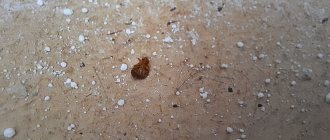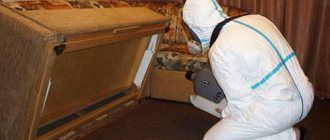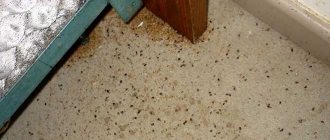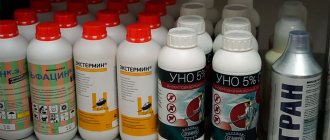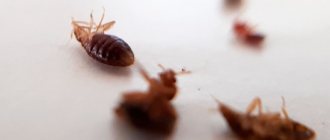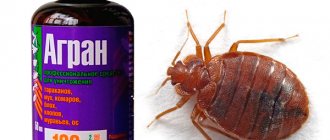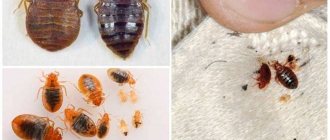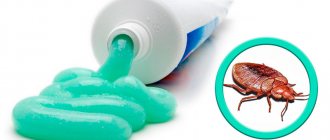Sometimes you can hear people complaining that professional treatment of an apartment for bedbugs did not bring one hundred percent results, and after a while the parasites returned again. This is most often due to non-compliance with exterminators’ recommendations for cleaning the premises after the procedure.
In this case, some single insects survive, and the problem again becomes relevant. To prevent parasites from reproducing, you need to understand what needs to be done after treating an apartment for bedbugs and when cleaning should be done.
What is pest control?
Disinsection is the professional treatment of premises using toxic agents that have a destructive contact and intestinal effect on parasites. In residential areas it is carried out using hot or cold fog. This allows you to destroy bedbugs in hard-to-reach places, as well as in furniture and clothing.
In the first case, a working fluid is poured into a special reservoir, which, when the compressor is turned on, is injected into the air under pressure and becomes finely dispersed. The settling of cold fog particles on the surface of the treated room occurs within 3-4 hours.
In the second case, after turning on the compressor and under the influence of the heating element, the working fluid is injected into the air in the form of steam, the particles of which settle on the surface within 8-10 hours.
Pest control
Advantages of professional cleaning after disinfestation
If you doubt that you can handle the cleaning yourself after treatment for cockroaches, order a cleaning service from a company that carries out pest control.
Advantages of comprehensive service from professionals:
- knowledge of the rules for cleaning after treatment with insecticides, which guarantees safety;
- compliance with safety precautions when working with chemicals, which prevents poisoning among residents;
- availability of the necessary personal protective equipment, you do not have to additionally buy rubber gloves, detergents, rags;
- quickly bringing the apartment into a habitable condition, which saves your time;
- modern cleaning technologies, efficiency, quality;
- control system, guarantee for work performed.
If necessary, you can order additional services - eliminating unpleasant odors, cleaning surfaces, tiles from limescale, fungus, rust, water stone. For this purpose, innovative techniques and equipment are used - steam cleaner, dry fog.
Airing the apartment
After the waiting period after disinfestation, all rooms must be thoroughly ventilated. You need to create a draft by opening windows and doors wide. To ensure safety in the treated room, it is necessary that the insecticide completely evaporates and its layer on the surfaces dries.
Attention! After disinfestation, the apartment should be ventilated for 2-3 hours. You cannot be in the room at this time to prevent poisoning.
Therefore, it is recommended to go outside and wait. After ventilation is completed, you can stay in the apartment after disinfestation without fear for your health.
Is re-processing necessary?
After disinsection, bedbugs die within a month.
Why don’t bedbugs die after treatment? Unfortunately, bedbugs are extremely tenacious and adapt well to poisons - the survival rate after etching can be up to 95%, and both adult parasites and eggs survive. If bedbugs continue to bite or have been noticed, it is necessary to re-treat the insects, but with a different poison that will kill more effectively.
Surviving bedbugs develop immunity against the chemical poison, which is passed on to their offspring.
If disinfection with chemicals does not help, you should contact the specialists again, clarifying that the specific poison did not work. The service will use another poison from which immunity has not yet appeared.
Important! Some experts recommend securing the result with a repeat procedure 10-14 days after the first treatment of the room.
Cleaning the apartment after bedbug poisoning
After disinfestation and ventilation of the rooms, minimal cleaning can be done. In this case, it is necessary to leave as many surfaces as possible on which there will be a dry layer of insecticide. The remaining parasites, while moving around the house, will come into contact with a toxic substance, which will lead to their death.
Cleaning
After disinfestation, it is recommended to wipe only:
- kitchen tables;
- taps;
- toilet;
- shells;
- surfaces of bedside tables;
- handles on doors and cabinets.
To neutralize the toxic effect of the insecticide, work surfaces must be washed with a soapy solution with the addition of soda. After this, wipe with a cloth soaked in plain water.
Attention! You can wash floors after disinfestation only in the room where children and pets usually play. But during the initial cleaning process, you should not wash off the insecticide from the baseboards, and you should also leave the areas under the beds and cabinets untouched.
After disinsection of the apartment, no stains remain on the furniture or floor from these blood-sucking parasites. Therefore, there is no urgent need for thorough cleaning.
What should you do with clothes and things in closets?
In our experience, there are almost never bedbugs in closets with clothes. Over 15 years of work, out of six exterminators, only one saw bedbugs in such cabinets, and that happened in catastrophically infested apartments. For this reason, wardrobes are treated with insecticide only from the outside, with the doors closed, and the drug does not get on the clothes themselves. Therefore, there is no need to do anything with it after sanitation.
If some items were hanging openly in the room and the product could get on them, then they will need to be washed and then safely worn further. When washing, all the insecticide is washed off from the clothes and when put on, the body will not come into contact with the product.
Is it possible to sleep on treated sofas and beds?
You can sleep on all beds and sofas after they have been disinfested for bedbugs. This is also necessary in order to provoke the surviving parasites to get out of their secluded shelter in search of a food source. As a result, they come into contact with the insecticide that remains on the surfaces after disinfestation.
If there are concerns that a toxic substance while sleeping on a treated sofa or bed may harm your health, you should cover the sleeping area with not one sheet, but two or three. You can also put several pillowcases on the pillows.
On a note! If, after disinfestation, a person does not sleep in the apartment, then the likelihood of destruction of the remaining surviving individuals is reduced. And this may cause them to reproduce again after some time.
The importance of cleaning the kitchen
The effectiveness of the entire pest control operation depends on proper cleaning of the kitchen, the main breeding ground for cockroaches. This room is treated especially carefully, if necessary with a solution of higher concentration. To ensure that your food is safe to eat, you need to properly remove any remaining chemicals.
Before pickling, all food items are removed from the kitchen and dining room. If by chance there are open or closed packages left in the cabinets, they are not suitable for consumption. Such products are collected in plastic bags, tightly sealed and thrown into the trash.
To avoid future poisoning, cleaning the kitchen involves more than just wiping down work surfaces. The interior walls and shelves of cabinets, bedside tables, and handles of household appliances (refrigerator, microwave oven) must be washed. Wipe the inner chamber of the oven and induction cooker panels. All dishes are washed in the dishwasher or by hand in the sink. After the cabinets have dried, you can put the food in its place.
What not to touch:
- skirting boards, radiators, radiators;
- tiled walls, tiles;
- the upper part of the refrigerator body, wall cabinets;
- window frame, glass taller than a person, cornices;
- hood, gas boiler, water heater (boiler);
- sockets, household appliance cables, adapters;
- water supply units (pipes, sewerage);
- waste collection place (tank, bucket);
- door frame, lighting fixtures.
What to do if there is still a strong smell after cleaning?
A persistent specific odor that persists after disinfestation indicates the use of a cheap drug for baiting bedbugs. Even wet cleaning done several times does not help get rid of it. In this case, the problem can only be eliminated by deodorizing the room.
This procedure involves treating the apartment with a dry fog, which neutralizes insecticide molecules on all surfaces. It helps get rid of an unpleasant odor, but the cost of such a service is equivalent to disinfestation against parasites.
Attention! To avoid having to deodorize your apartment later, you should immediately refuse the services of disinfectants with a dubious reputation and suspiciously low prices.
Room deodorization
When is it necessary to thoroughly clean the premises?
It is necessary to completely clean the room after baiting bedbugs after 5-6 days, if during this time neither live parasites nor their bites on people were found.
If there are live bugs in an apartment, or from time to time people discover bites on themselves, you need to find out what kind of parasites they are - survivors of persecution, or those that entered the room from neighbors. Depending on this, subsequent actions need to be taken. We talked about this in detail when we looked into how quickly bedbugs die after treatment...
If there are no bedbugs left in the apartment, then 5 days is enough to make sure of this. After this, you can do a complete wet cleaning:
- Vacuum all floors, baseboards and carpets (including those that were rolled up before disinfestation);
- Wash the floors in all rooms;
- Wash baseboards, window sills, lower surfaces of window sills;
- Wipe the back and side walls of furniture (including cabinets and bookshelves) with a damp cloth;
- Remove mattresses from beds, wipe the frame and frame with a damp cloth, and wipe the inside surfaces of linen drawers in sofas;
- Wipe the door frames with a damp cloth;
- Vacuum carpets hanging on the walls.
In general, this should be a full-fledged general cleaning, during which all surfaces sprayed during treatment will be washed.
After such cleaning, you can be sure that there are no bedbugs or insecticide in the apartment
There is no need to wash upholstered furniture with anything special after treatment. It is enough to vacuum it several times during regular cleaning. After this, there will be no dry insecticide left on its surface.
What if there are signs of poisoning?
After baiting bedbugs, signs of poisoning may appear only if safety rules are not followed. This can happen if a person entered the room without a respirator during the treatment, or the apartment was not well ventilated after treatment.
Symptoms of poisoning:
- increased salivation;
- tearfulness;
- runny nose;
- unpleasant taste in the mouth;
- sore throat;
- dizziness;
- nausea.
If alarming signs appear, you need to go out into the fresh air and breathe. It is recommended to take absorbents if the insecticide gets into the digestive tract, otherwise there is no need for it.
What should you do immediately upon returning?
First of all, after returning to the apartment, you need to:
- Ventilate all rooms with a cross-flow of air. Simply put, organize a draft so that all rooms are ventilated. You need to ventilate the room for at least half an hour, preferably an hour and a half.
- If clusters of dead or dying bedbugs are found somewhere, then collect them with a broom and flush them down the toilet.
After baiting bedbugs with certain preparations (mostly domestically produced), a characteristic chemical odor may remain in the room, which only weakens, but does not disappear after ventilation. There is no need to be afraid of it - the smell itself is not dangerous and cannot lead to poisoning; it is emitted by a dry preparation on walls, floors and furniture. From those domestic poisons that our specialists work with, this smell disappears in 2-3 days, including from soft furniture elements. This means that you should not try to get rid of this smell immediately, during the first airing.
Therefore, by the way, although imported drugs are a little more expensive (and their treatment is a little more expensive), they are also preferable, since after treatment with them there is no smell left at all and you can be quite comfortable in the apartment immediately after returning.
Hot fog treatment
At first - half an hour to an hour - during ventilation there should be only one person in the room wearing a respirator, or at least a cotton-gauze bandage. If there is no respirator, then you need to enter the room, open all the windows, remove the bags from the ventilation grilles (the disinfectant secures them here before etching), leave the front door open and leave. For the next half hour or hour, you can stay near the front door, but outside the room. After this, all people can enter the apartment and begin cleaning it. Children and pets can only be brought into the premises after cleaning.
Contact a reliable service
Not only professionals work in the sanitation services market. Unfortunately, there are plenty of hacks and amateurs. If the apartment continues to be attacked by bedbugs after disinfestation, it is possible:
- Employees of the company that took over the processing saved the drug or diluted it incorrectly.
- Inaccurate calculations of the area of the room were made (the intensity of the impact depends on this).
- Disinfectors left certain areas of the apartment untreated.
It is important to know: repeated treatment against bedbugs is possible no earlier than after 3 weeks. Contacting the SES “Pest Control Service” is a guarantee of a professional approach and effective results.
How long should I wait
In many ways, the death of insects depends on the quality of disinfestation. Even analyzing the features of the room, identifying areas where bed bugs accumulate, and thoroughly treating bedding and furniture cannot guarantee that bed bugs will stop biting. These insects like to hide in secluded places, especially to lay larvae there. The peculiarity of bed bugs is that they do not have a complete phase of transformation from the larva, which allows individuals that have just hatched from the egg to move and bite.
To understand why bed bugs still bite after treatment, you need to know two important points regarding the life activity of this species:
- Each female lays up to 20 eggs at one time, and up to 500 throughout her life;
- Development in the egg lasts several days, and the adult becomes an adult within a month.
Such scientific data suggests that a month is the minimum period for completely getting rid of bedbugs. During this period, it will not be possible to avoid insect bites. Additional treatment of the premises after a couple of weeks will help to significantly reduce the number of bed bugs and consolidate the effect of the first disinfestation.
Disinfestation of bedbugs
Too many bedbugs?
In rare cases, the concentration of bedbugs in a room may exceed reasonable limits, and then treatment alone will not help. As a rule, pest control services warn in advance about the need for re-treatment, based on their experience. If you decide to destroy bedbugs yourself, be prepared for the fact that if there are too many insects, you will have to carry out the procedure again in 3-4 weeks. At the same time, it is strictly recommended to change the composition of the drug, as after the first treatment the bedbugs will develop immunity to the poison. And be sure to use only professional pest control products: using an inexpensive aerosol will provide you with the fight against bedbugs for years to come.
In what cases is repetition necessary?
Sometimes people continue to see bedbugs even though they have died long ago.
If bedbugs appear again after disinfestation, repeated chemical treatment will be required. It is necessary in the following cases:
- The bugs continue to bite, they were not killed the first time;
- The habitat changed, but the insects did not go far: for example, they moved from the bedroom to the nursery;
- Not all insects died the first time. This may be due to failure to follow the recommendations of the exterminators, poor preparation before the procedure (for example, the specialist was unable to get to the corner where the surviving individuals had accumulated), too much contamination of the room, quickly cleaned the home (the poison did not have time to take effect);
- The apartment was re-infected - new individuals entered the apartment;
- Often there is a psychological factor: the bedbugs have disappeared, but residents think that they remain and continue to bite. This creates the illusion that the pests have not been completely destroyed.
Bedbugs are extremely tenacious parasites that easily adapt to the action of chemical poison. If after disinfestation there are still live bugs, you will have to call sanitation specialists again. At the same time, they must treat the room with another poison, to which the insects do not yet have immunity.
How is repeated disinfestation performed?
Repeated treatment by a specialist begins with an inspection and analysis of the premises: by this time the bedbugs may change their location. After examining the environment, the specialist sprays the chemical, paying special attention to hard-to-reach areas.
During disinfestation, another insecticide may be used, more powerful than in the first treatment.
Check your neighbors
If you have poisoned bedbugs, but the insects have not disappeared, it makes sense to contact your neighbors. It is quite possible that pest outbreaks are located in their area. In search of a new home, bedbugs can migrate from neighbors to you through ventilation, cracks in the floor and baseboards. In this case, treating one apartment will not solve the problem; after some time, the insects will return and annoy you with bites. It makes sense to cooperate with your neighbors and carry out professional extermination of bedbugs in several houses at once. For prevention, you can also close the ventilation with a fine mesh and seal the cracks in the baseboards. From now on, this will protect you from neighboring insects, be it bedbugs, cockroaches, flies or others.
We had an order from a client and there were bedbugs in the bed. When we arrived, it turned out that we had already been poisoned a month ago, but the bedbugs had not disappeared. We checked the whole apartment again, it turned out that the ventilation was poorly sealed, we went to the neighbors, they also had a problem with bedbugs. The neighbors poisoned them themselves the old fashioned way, with a spray; the insects had already developed immunity to dichlorvos; as soon as they started poisoning them, they crawled through the ventilation to our client. In the end, we agreed, our service poisoned 3 apartments on the floor, after that the parasites seemed to disappear, no angry calls were received
Valentin, Anti-Bed Master. Saint Petersburg
